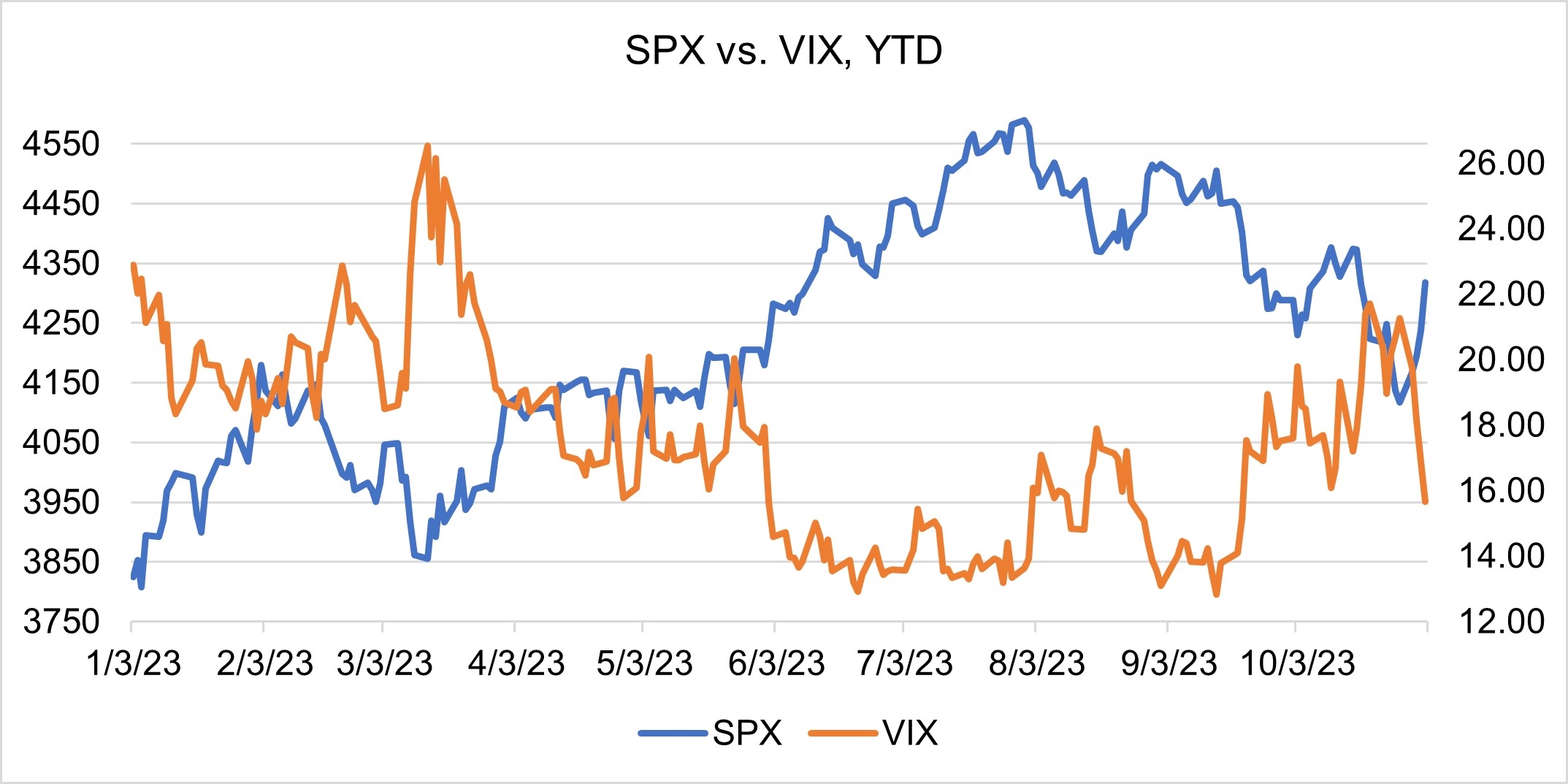A Muted VIX. What is the Upside Potential?

By Brett Friedman, Winhall Risk Analytics/OptionMetrics Contributor
Given the significantly increased tensions due to the war in the Middle East, and its unexpected nature, the reaction of the VIX has been muted, to say the least. In the two weeks following the unexpected outbreak of war in the Middle East, the VIX staged a 4 point rally to reach a near term high of 21.70 on 10/20. The war served to accelerate the bullish trend already in place since the YTD low of 12.82 was made on September 14. Although it rose to levels not seen since the beginning of the regional banking crisis last March, VIX gains were short lived.
After the initial shock of the unexpected war in the Middle East, the VIX quickly drifted back into the mid-teens, familiar territory, giving up all of its gains a mere 16 trading days after the beginning of the war. That leads to a question: is the current market too complacent or was the relatively brief upside move in the VIX a harbinger of things to come? And, more generally, how does the VIX's reaction to the war in the Middle East compare to other significant economic and political events, such as the 2008 financial crisis, the Covid pandemic, the war in Ukraine, and the regional banking crisis?
The interrelated factors that drive the VIX -- uncertainty, as reflected in the risk premium, as well as daily direction and changes in the SPX -- can offer an answer. The degree to which these factors influence the index is not constant but varies depending on the most recent market and political developments. For example, the uncertainty factor, as reflected in the risk premium, dominated the VIX's movement in the period immediately following the outbreak of war in the Middle East. That being said, its increase and range was less than occurred in previous crises:



Overall, the VIX's initial reaction to the war was muted, at best, especially when compared to previous crises:

Most recently, the initial shock of the war and the resulting uncertainty as a factor driving the VIX has been receding, and the inverse relationship of the VIX to the SPX has been reasserting itself:
Source: OptionMetrics
Apparently, VIX traders believe that the war will not spread regionally and will remain contained, with little direct impact on the SPX, petroleum supply, or global financial conditions. Ignoring this possibility, they have driven the VIX lower in reaction to the most recent SPX rally. However, the war is in its early days and its medium to long term ramifications are not all clear.
VIX levels in the mid-teens seem to be overly discounting the probability that the war could metastasize into a broader, more serious, and influential conflict. Such expansion could lead to significantly higher levels as the uncertainty factor comes to the fore. As such, and with the VIX trading in the mid-teens, the upside/downside risk of a short VIX position does not seem to be favorable at this time.
--------------------------------------------------------------------------------------------------------------------------------------------------------------------------------------------------------------------------------
Brett Friedman is managing partner at Winhall Risk Analytics and a contributor to OptionMetrics. He has managed risk for over 30 years and has broad experience working with financial institutions in risk management and trading strategy. Mr. Friedman has built and managed three risk management organizations, two trading startups, and has transacted on numerous exchanges and OTC markets.
Prajwal Pitlehra, a FRE candidate at the NYU Tandon School of Financial Engineering, assisted in the production of this article.
Found this useful?
Take a complimentary trial of the FOW Marketing Intelligence Platform – the comprehensive source of news and analysis across the buy- and sell- side.
Gain access to:
- A single source of in-depth news, insight and analysis across Asset Management, Securities Finance, Custody, Fund Services and Derivatives
- Our interactive database, optimized to enable you to summarise data and build graphs outlining market activity
- Exclusive whitepapers, supplements and industry analysis curated and published by Futures & Options World
- Breaking news, daily and weekly alerts on the markets most relevant to you





